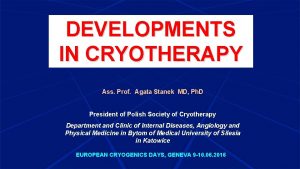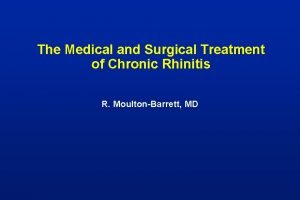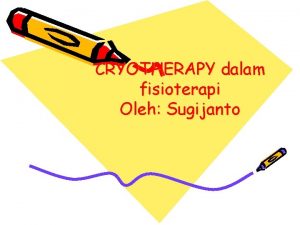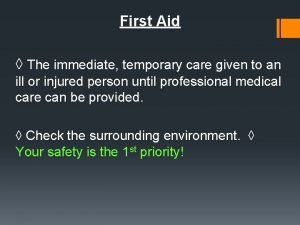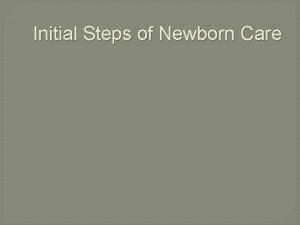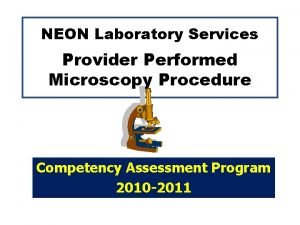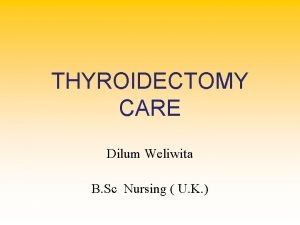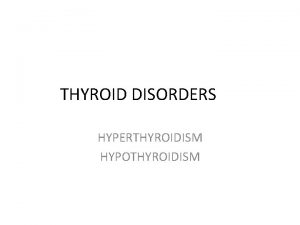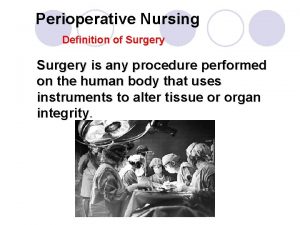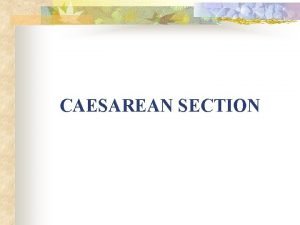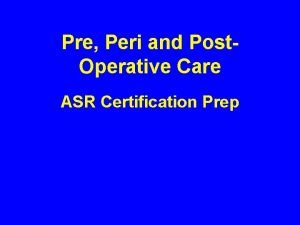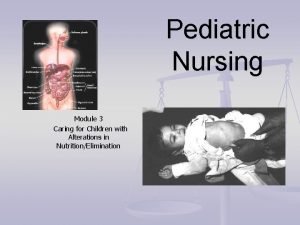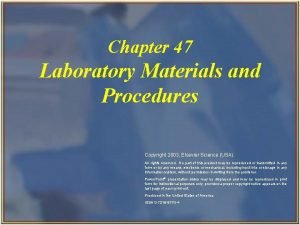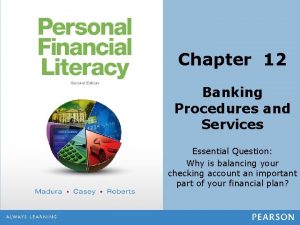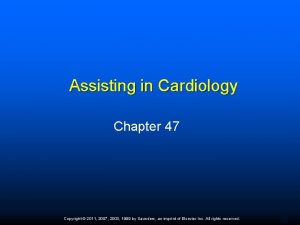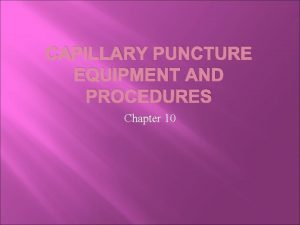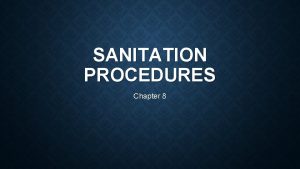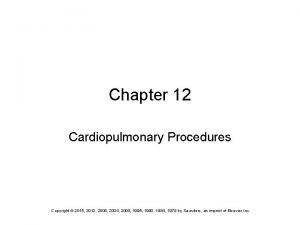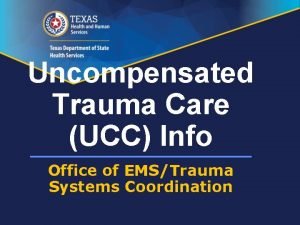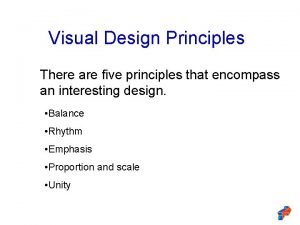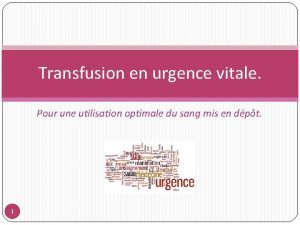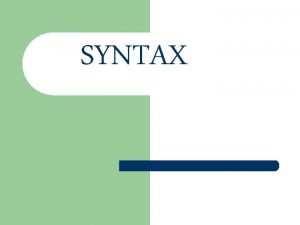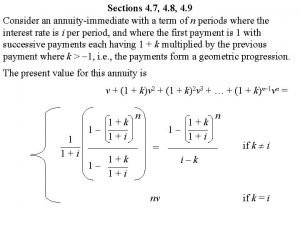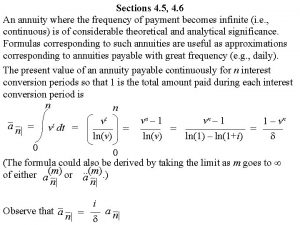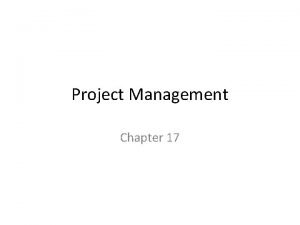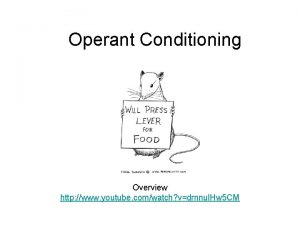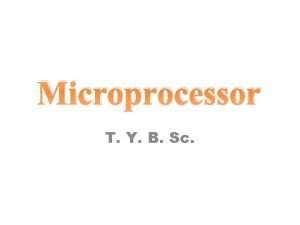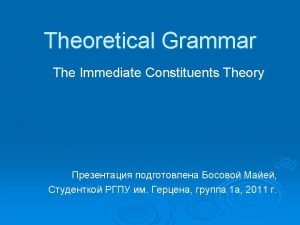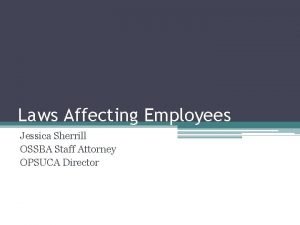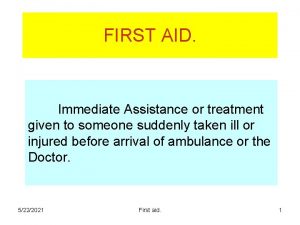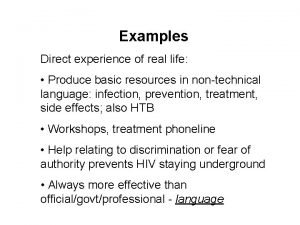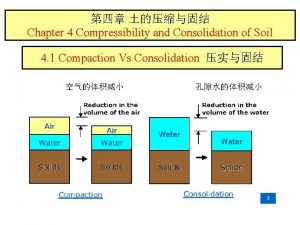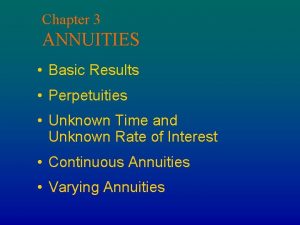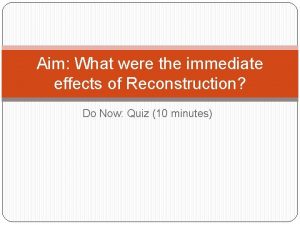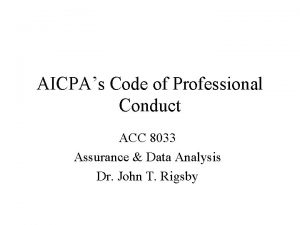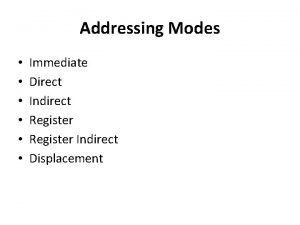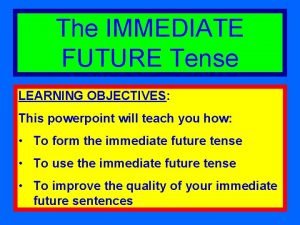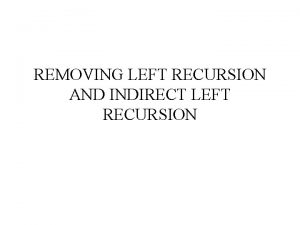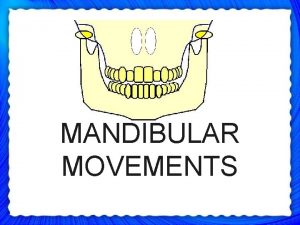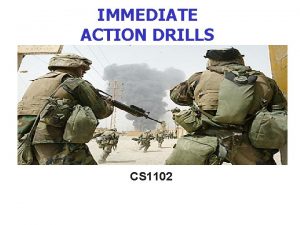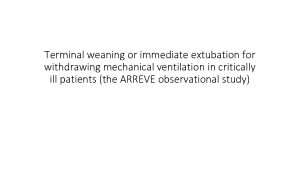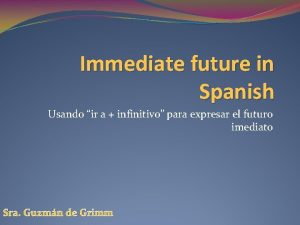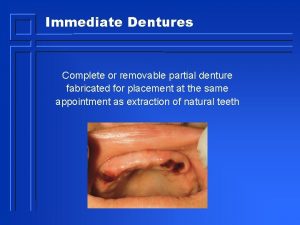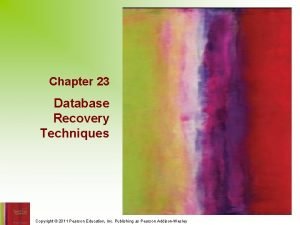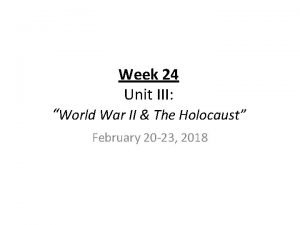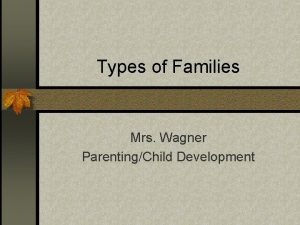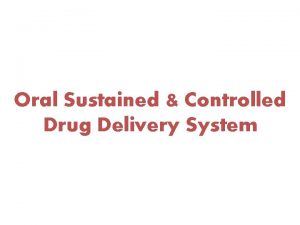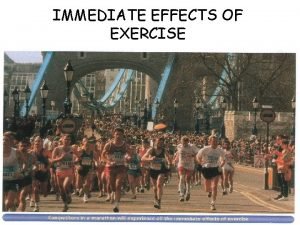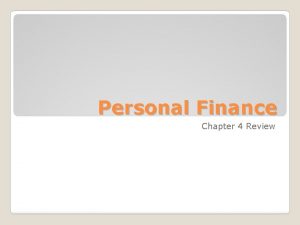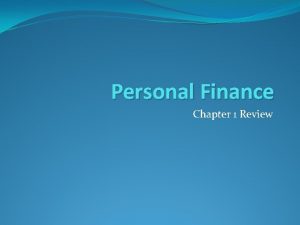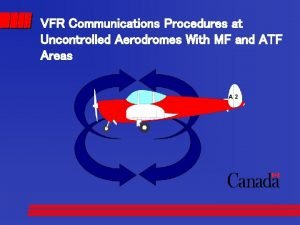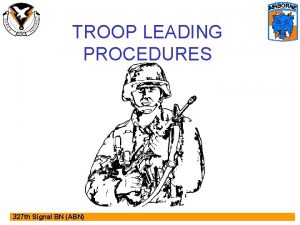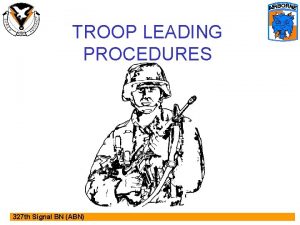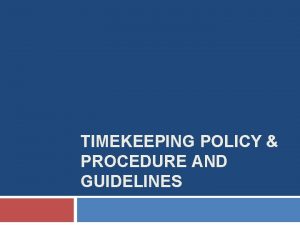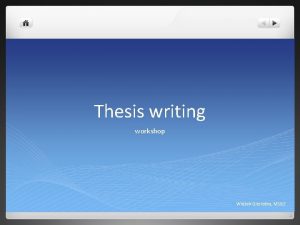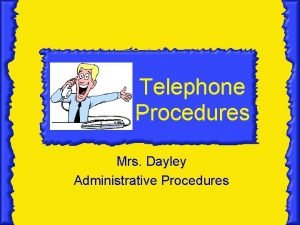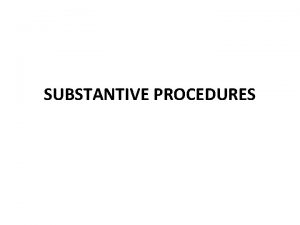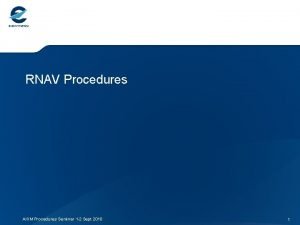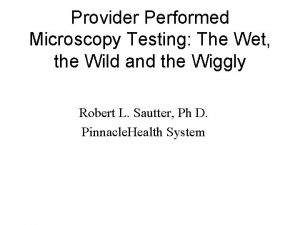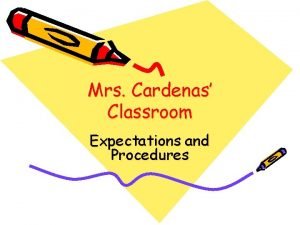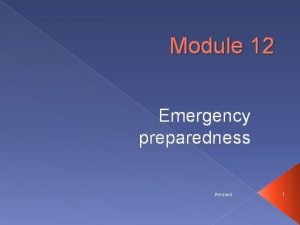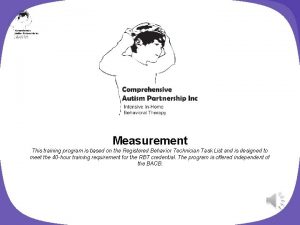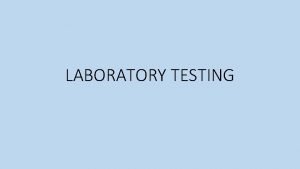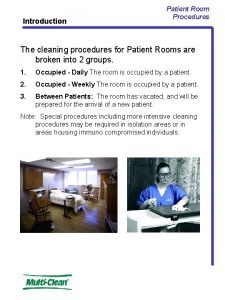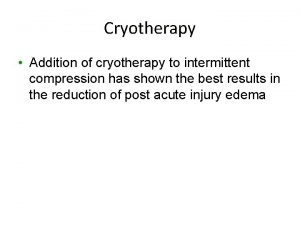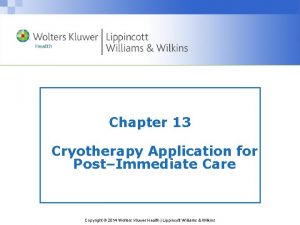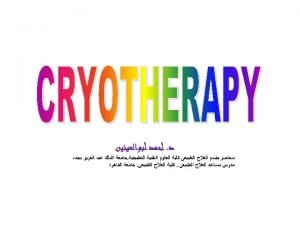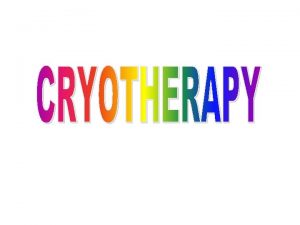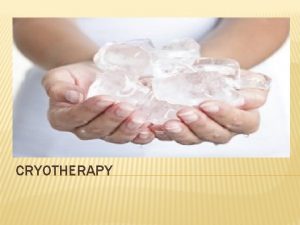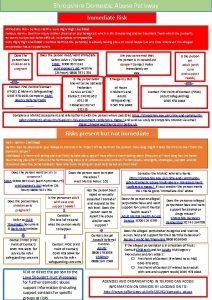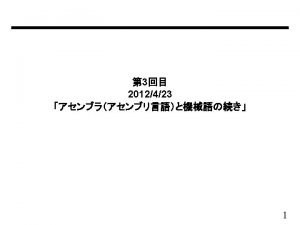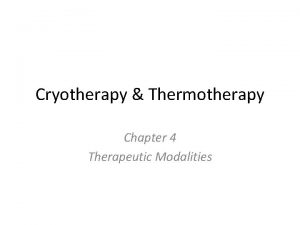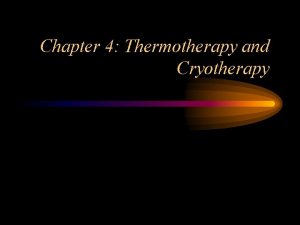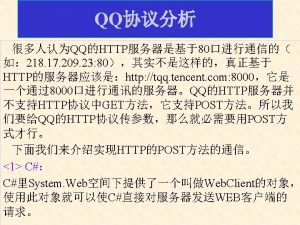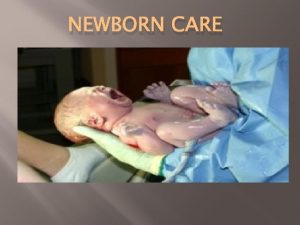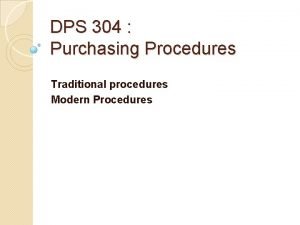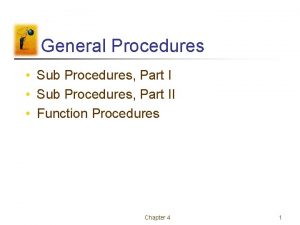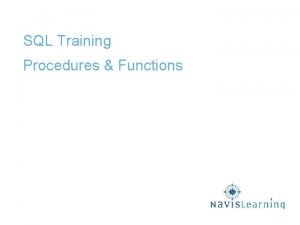Chapter 14 Application Procedures Post Immediate Care Cryotherapy




















































































































- Slides: 116

Chapter 14. Application Procedures: Post– Immediate Care Cryotherapy © 2008 LWW

Transition and Subacute Care Cryotherapy • Begin once secondary injury stops • Usually within 24 hr • Used for very different reasons than during immediate care – Decrease pain and inhibition – Facilitate pain-free therapeutic exercise © 2008 LWW

Transition and Subacute Care Cryotherapy (cont. ) • Application types and times differ • The key: exercise, not the cold © 2008 LWW

Local Numbing with Cryotherapy • Ice water immersion • Ice massage • Ice bag (occasionally) © 2008 LWW

Ice Water Immersion • Ice bath immersion – Not ice water submersion • Key points – Large enough container • Plastic or rubber best – Fill with ice, then water. • Goal is 32– 34°F (0– 1°C). – Warmer water does not numb as effectively. © 2008 LWW

Ice Water Immersion (cont. ) • Initial cooling usually quite painful; help patient adapt by – Giving patient a choice before beginning treatment. – Assuring patient that subsequent bouts and sessions will be much less painful. – Using a toe cap to minimize pain. – Talking to patient during initial immersion to take her mind off the cold. – Making sure patient goes through multiple immersion bouts during first session. © 2008 LWW

Ice Massage • Slowly stroke muscle with ice pop. • Discontinue when numb. • Adding a plate weight will increase numbness. © 2008 LWW

Ice Massage (cont. ) • Prepare ice pops by – Freezing water in 6– 8 oz. paper cups – Add tongue depressor to some for handle. © 2008 LWW

Transition and Subacute Care Cryotherapy: Techniques • • Cryokinetics Cryostretch Contrast bath Connective tissue stretch © 2008 LWW

Cryokinetics Combination of cold application and active exercise © 2008 LWW

Why Cryokinetics? • Cold decreases pain, which – Facilitates active exercise • Exercise – Reduces swelling (dramatically) through muscular milking action – Promotes healing and return to function – Reduces inhibition © 2008 LWW

Cryokinetics: Disadvantages • Pain during initial session • Cold can be messy. © 2008 LWW

Cryokinetics: Indications • Sprains—dynamite treatment – Ankle (especially) – Fingers © 2008 LWW

Cryokinetics: Contraindications • Any exercise or activity that causes pain • Use of ice on a patient who is hypersensitive to cold © 2008 LWW

Cryokinetics: Precautions • Use pain as a guideline. – Warn patient not to gut out pain. • Don’t allow patient to limp. • May be an increase in pain 4– 8 hr after treatment © 2008 LWW

Cryokinetics: Overview • Typically consists of five bouts of exercise interspersed with cold application for numbing © 2008 LWW

Cryokinetics Preapplication Tasks for Proper Modality • Reevaluate injury. • Review previous treatment, if any. • Confirm that objectives of therapy are compatible with cryotherapy, • Check that cryokinetics is not contraindicated. © 2008 LWW

Cryokinetics Preapplication Tasks for Psychological Preparation • Explain sensations • Cold very painful during first immersion. – Adapt thereafter – Benefits of treatment outweigh temporary pain © 2008 LWW

Cryokinetics Preapplication Tasks for Physical Preparation • Remove clothing as necessary. • Position patient. © 2008 LWW

Cryokinetics Preapplication Tasks for Equipment Preparation • Container and ice or ice pop • Toe cap is helpful. • Towels to sop up water © 2008 LWW

Cryokinetics Application to Numb Body Part • Apply ice. – Immersion is best. • 1°C water – Use ice massage if cannot immerse. © 2008 LWW

Cryokinetics Application to Numb Body Part (cont. ) • Apply until body part is numb. – Usually 10– 20 min – Goal is numbness, not time – Stop application after 20 min whether or not patient feels numb • Some people (10– 20%) cannot tell when they are numb. © 2008 LWW

Cryokinetics Application to Numb Body Part (cont. ) • Toe cap or sock keeps toes warm. © 2008 LWW

Cryokinetics Application for Exercise • As long as numb (~3 min) • Reapply ice until numb again (3– 5 min) • Exercise–ice–exercise–ice • Five exercise bouts per treatment • Exercise, not ice, causes rehabilitation. © 2008 LWW

Principles of Cryokinetics Exercise • All exercise should be active. • Performed by the patient • Exercise must be graded • Begin with range of motion exercises. • Progress through increasing levels of difficulty. • Full sport activity is final level. • Example for ankle injury follows. © 2008 LWW

Principles of Cryokinetics Exercise: Example • Let pain be your guide. • Never use an exercise that causes pain. • If painful, return to former activity level. • Go through complete ROM (or as much as is possible). • Perform all exercise without ankle taping, as long as ice is being used. © 2008 LWW

Principles of Cryokinetics Exercise: Example (cont. ) • Non-weight-bearing ROM – – – Plantar flexion Dorsiflexion Inversion Eversion Circumduction © 2008 LWW

Principles of Cryokinetics Exercise: Example (cont. ) • Weight-bearing ROM – Stand up. – Shift weight from foot to foot. – Gradually increase weight on injured limb. © 2008 LWW

Principles of Cryokinetics Exercise: Example (cont. ) • Walk 1 • • • Small steps Heel to toe Slow and deliberate • • No limp No pain Progress to. . . © 2008 LWW

Principles of Cryokinetics Exercise: Example (cont. ) • Walk 2 • • • Medium steps Slow and deliberate Then a little faster • • No limp No pain Progress to. . . © 2008 LWW

Principles of Cryokinetics Exercise: Example (cont. ) • Walk 3 Large steps Straight ahead Around things or in lazy S • Injured leg inside and outside curve Progress to. . . • • • © 2008 LWW

Principles of Cryokinetics Exercise: Example (cont. ) • Stretch heel cords, if necessary © 2008 LWW

Principles of Cryokinetics Exercise: Example (cont. ) • Strengthen muscles Dorsiflexion, eversion, inversion • With Elgin ankle exerciser Progress to. . . • © 2008 LWW

Principles of Cryokinetics Exercise: Example (cont. ) • Jog Straight ahead Lazy S Sharp Z Work into running Progress to. . . • • © 2008 LWW

Principles of Cryokinetics Exercise: Example (cont. ) • Four-square exercises © 2008 LWW

Principles of Cryokinetics Exercise: Example (cont. ) • Perform individual drills • With ankle taped • ½ speed • ¾ speed • Full speed © 2008 LWW

Principles of Cryokinetics Exercise: Example (cont. ) • Perform team drills • With ankle taped • ½ speed ¾ speed • Full speed • © 2008 LWW

Cryokinetics: Summary • Exercise – – – After numbing (12– 20 min) For as long as numb (~3 min) Reapply ice until numb again (3– 5 min) Exercise–ice–exercise–ice Five exercise bouts per treatment Exercise, not ice, causes rehabilitation. © 2008 LWW

Cryokinetics: Summary (cont. ) • When to begin – – Within 30 min if first-degree sprain Next day if second-degree sprain Never if third-degree sprain With cryostretch if strain © 2008 LWW

Cryokinetics: Application Parameters • Dosage – Exercise as vigorously as possible but within the limits of pain. – Most new clinicians will not encourage their patients to progress as rapidly as possible. © 2008 LWW

Cryokinetics: Application Parameters (cont. ) • Length of application – Five exercise bouts per treatment session • Frequency of application – Two or three times per day • Duration of therapy – Until patient returns to full, unhindered activity © 2008 LWW

Cryokinetics Postapplication Tasks • Instructions to the patient – Leave with the same joint support you came with. – If after a few hours the support is not needed, discontinue using it. – Be active, as long as pain free. – May feel pain in 4– 8 hr; if so, apply an ice pack for 30 min. • Schedule the next treatment. • Record treatment, including unique patient responses. • Clean up area. © 2008 LWW

Cryokinetics: Maintenance • Replace slush container when it cracks. • Sew sides of toe caps if they rip. © 2008 LWW

Cryostretch for Muscle Injuries • Most (strains and contusions) result in muscle spasm or tightness. • Many mild muscle pulls are actually muscles in spasm rather than torn muscle fiber. • Reduce spasm with cryostretch. © 2008 LWW

Rehabilitation Goals • • Promote healing, if tissues torn. Control pain. Reduce spasm. Control neural inhibition. © 2008 LWW

Rehabilitation Goals (cont. ) • Reset central control through aggressive, progressive reorientation to full function. • Develop muscle strength. • Promote other phases of rehabilitation as explained earlier. © 2008 LWW

Begin with Cryostretch Then transition into cryokinetics (for firstand second-degree injuries) © 2008 LWW

Cryostretch: Foundation • Combination of the muscle spasm reduction techniques • Cold application • Static stretching • Hold–relax technique of PNF © 2008 LWW

Cryostretch: Foundation (cont. ) Ice Static stretch Isometric contraction © 2008 LWW

Cryostretch: Effects • Ice decreases pain and muscle spasm. • Static stretching overcomes stretch reflex, thus decreasing muscle spasm. • Relaxation after maximal muscular contraction is greater than before contraction. © 2008 LWW

Cryostretch: Advantages l l Combined procedure more effective than the sum of the three individual components Ice inexpensive; exercise free © 2008 LWW

Cryostretch: Disadvantages l Ice is painful to some people. l l But massage not as painful as ice immersion. Melting ice can be messy. © 2008 LWW

Cryostretch: Indications l l l Any muscle with residual, low-grade muscle spasm Any first-degree muscle strain A muscle that is stiff from prolonged disuse (immobilization) l Do not confuse this with decreased ROM owing to connective tissue contractures. © 2008 LWW

Cryostretch: Contraindications l l Any exercise or activity that causes pain Use of ice on a person who is hypersensitive to cold © 2008 LWW

Cryostretch: Precautions • Don’t allow patient to consciously or willfully overcome or gut out the pain. • There may be an increase in pain 4– 8 hr after treatment. • Isometric contractions must begin and end gradually. – Sudden starts or stops may tear muscle fibers. © 2008 LWW

Cryostretch: Application Parameters • Three sets – Numb with ice then activity • Activity consists of two 65 sec bouts of exercise with 20 sec rest between bouts • 65 sec bout – Stretch muscle to limits and hold 20 sec – Three static stretches, interspersed with maximal isometric contraction (hold–relax) © 2008 LWW

Cryostretch: Application Parameters (cont. ) – Example exercise bout • • 20 sec static stretch 5 sec isometric contraction 10 sec static stretch © 2008 LWW

Cryostretch: Application Parameters (cont. ) Numb/renumb Static stretch Isometric contraction First bout Second bout © 2008 LWW First set Second set Third set

Cryostretch: Application Parameters (cont. ) • • Numb muscle (20 min max) 65 sec stretch–contraction 20 sec rest Repeat 65 sec stretch–contraction Renumb Two more stretching bouts (20 sec rest) © 2008 LWW

Cryostretch: Application Parameters (cont. ) Numb (20 min max), with ice massage © 2008 LWW

Cryostretch: Application Parameters (cont. ) • Neuromuscular training – Part of first day, first bout only – Help patient feel the use of the affected muscle by actively contacting it through ROM. – Offer minimal resistance. – Repeat two to three times. © 2008 LWW

Cryostretch: First Bout, First Stretch • 20 sec static stretch – Stretch muscle to limit; hold 20 sec © 2008 LWW

Cryostretch: First Bout, First Contraction • 5 sec isometric contraction – Instruct patient to begin and end slowly. – No quick stops and starts – Instruct patient to attempt the same movement as before, but this time you will hold body part so it doesn’t move. © 2008 LWW

Cryostretch: First Bout, Second Stretch • 10 sec static stretch – Take up slack from first contraction. – Move to limits of tightness/pain. – Hold 10 sec. © 2008 LWW

Cryostretch: First Bout, Second Contraction • 5 sec isometric contraction – Instruct patient to begin and end slowly, as before. © 2008 LWW

Cryostretch: First Bout, Third Stretch • 10 sec static stretch – Take up slack from second contraction. – Move to limits of tightness/pain. – Hold 10 sec. © 2008 LWW

Cryostretch: First Bout, Third Contraction • 5 sec isometric contraction – Instruct patient to begin and end slowly, as before. © 2008 LWW

Cryostretch: Between First and Second Bout • Rest 20 sec © 2008 LWW

Cryostretch: Second Bout • Repeat first bout – 65 sec © 2008 LWW

Cryostretch: Second and Third Sets • Renumb (5 min max) • Repeat set © 2008 LWW

Cryostretch: Overall Numb/renumb Static stretch Isometric contraction © 2008 LWW

Cryostretch: Miscellaneous Tips • Use shoulder if patient is too big. © 2008 LWW

Cryostretch: Miscellaneous Tips (cont. ) • Stretch muscle until pain or tightness is felt, then back off until pain disappears. © 2008 LWW

Cryokinetics: Application Parameters Revisited • Dosage – Exercise as vigorously as possible but within the limits of pain. – Most new clinicians will not encourage their patients to progress as rapidly as possible. © 2008 LWW

Cryokinetics: Application Parameters Revisited (cont. ) • Length of application – Five exercise bouts per treatment session • Frequency of application – Two to three times per day • Duration of therapy – Until patient returns to full, unhindered activity © 2008 LWW

Cryokinetics: Postapplication Tasks Revisited • Instructions to the patient – Leave with the same joint support you came with – If after a few hours the support is not needed, discontinue using it. – Be active, as long as pain free. – May feel pain in 4– 8 hr; if so, apply an ice pack for 30 min. © 2008 LWW

Cryokinetics: Postapplication Tasks Revisited (cont. ) • Schedule the next treatment. • Record treatment, including unique patient responses. • Clean up area. © 2008 LWW

Cryokinetics: Maintenance Revisited • Replace slush container when it cracks. • Sew sides of toe caps if they rip. © 2008 LWW

Combined Cryostretch and Cryokinetics • Begin once spasm begins to abate. – Often within 2– 3 days • Replace stretching with active (isotonic) exercise. © 2008 LWW

Combined Cryostretch and Cryokinetics (cont. ) • Begin and end with stretch. • Begin cryokinetics exercises with manually resisted muscle contractions (6– 10) through a full ROM. © 2008 LWW

Combined Cryostretch and Cryokinetics (cont. ) • Once strength begins to return (2–days), switch to some type of isotonic weight lifting • Use DAPRE technique © 2008 LWW

Combined Cryostretch and Cryokinetics (cont. ) Progress through all phases of rehabilitation using progressive functional activities. © 2008 LWW

The Last Word on Muscle Injury • Muscle injury is often the result of failure to – Properly strengthen muscle – Resume full activity in a progressive, gradual way • Don’t allow the patient to return to explosive activity prematurely. © 2008 LWW

Connective Tissue Stretch • Technique to break tissue contractures • Used to increase joint flexibility after prolonged immobilization © 2008 LWW

Connective Tissue Stretch: Foundation • Combination of – Heat application – Long-term passive stretch – Cold applications © 2008 LWW

Connective Tissue Stretch: Foundation (cont. ) • 45 min treatment © 2008 LWW

Connective Tissue Stretch: Effects • Heat causes collagen cross-bridges to relax. • Stretch lengthens the collagen. • Cold causes the collagen cross-bridges to reattach in a lengthened position. © 2008 LWW

Connective Tissue Stretch: Advantages • Heat applications minimize collagen tearing by inducing cross-bridge relaxation. • Cold applications cause the crossbridges to reform in a lengthened position, thus preserving the gains made during stretching. • Minimal equipment needed © 2008 LWW

Connective Tissue Stretch: Disadvantages • Boring treatment © 2008 LWW

Connective Tissue Stretch: Indications • Anytime connective tissue contractures prevent full ROM © 2008 LWW

Connective Tissue Stretch: Contraindications • Any exercise or activity that causes pain • Use of ice on a person who is hypersensitive to cold © 2008 LWW

Connective Tissue Stretch: Precautions • Avoid pain during stretching. – Usually occurs because resistance is too great © 2008 LWW

Connective Tissue Stretch: Alternatives – Diathermy – Mobilization © 2008 LWW

Connective Tissue Stretch: Application Parameters • Heat injured joint for 15– 30 min, depending on modality used. – Shortwave pulsed diathermy is preferred for heating large areas (15– 20 min). – Moist hot packs if diathermy unavailable (30 min). – Apply to both sides if it is a large joint. – Change hot packs after 15 min to compensate for their cooling. © 2008 LWW

Connective Tissue Stretch: Application Parameters (cont). • Stretch joint with low-level continuous passive force for 15 min. – Begin after 15 min of heating. – Use external force • Example: 3– 15 lb weight – No manual resistance – No specific way to apply resistance • Use your ingenuity. © 2008 LWW

Connective Tissue Stretch: Application Parameters (cont. ) • Discontinue heating and begin cooling after 15 min of stretching. • Maintain stretch – Collagen fibers that detached during heating will reattach during cooling if joint is held in lengthened position. © 2008 LWW

Connective Tissue Stretch: Application Parameters (cont. ) • Dosage – As much resistance as comfortable © 2008 LWW

Connective Tissue Stretch: Application Parameters (cont. ) • Length of application – 45 min per treatment session • Frequency of application – Two to three times per day • Duration of therapy – Until patient returns to full, unhindered activity. © 2008 LWW

Connective Tissue Stretch: Postapplication Tasks • Instructions to the patient – Be active, as long as pain free. – May feel pain in 4– 8 hr; if so, apply an ice pack for 30 min. © 2008 LWW

Connective Tissue Stretch: Postapplication Tasks (cont. ) • Schedule the next treatment. • Record treatment, including unique patient responses. • Clean up area. © 2008 LWW

Lymphedema Pumps • Pumps attached to boot or sleeve and force air or water into sleeve. • Pumps turn on and off so sleeve alternates inflating and deflating, providing intermittent compression. © 2008 LWW

Lymphedema Pumps: Foundation • Formerly called: – – Intermittent compression pumps Cold compression devices Pneumatic compression pumps Intermittent compression devices © 2008 LWW

Lymphedema Pumps: Foundation (cont. ) • Classified as: – – Pneumatic (air) Cryocompression (chilled water) Circumferential (all at once) Sequential (distal to proximal) © 2008 LWW

Lymphedema Pump: Effects • Changes in sleeve pressure forces lymphatic and venous drainage and thus reduces edema. – Permanent edema reduction requires free protein and cellular debris removal from tissue. – So capillary filtration pressure is normalized. • Lymphatic and venous systems contain one-way valves that allow contents to move proximally but block distal movement. © 2008 LWW

Lymphedema Pump: Advantages • Requires minimal clinician time © 2008 LWW

Lymphedema Pump: Disadvantages • Slow rate of boot/sleeve inflation • Tissue compression rate much faster with active exercise and massage. © 2008 LWW

Lymphedema Pump: Indications • • • Post-traumatic edema Postoperative edema Chronic edema Primary and secondary lymphedema Venous stasis ulcers Persistent swelling from venous insufficiency © 2008 LWW

Lymphedema Pump: Contraindications • In patients suffering from: – – – Compartment syndrome Peripheral vascular disease Arteriosclerosis Deep vein thrombosis Local superficial infection Edema secondary to congestive heart failure Ischemic vascular disease Gangrene Dermatitis Acute pulmonary edema Displaced fractures © 2008 LWW

Lymphedema Pump: Precautions • Avoid pain during treatment. © 2008 LWW

Lymphedema Pump: Alternatives • Active muscle activity • Massage © 2008 LWW

Lymphedema Pump: Preapplication Tasks • Same as cryokinetics preapplication tasks © 2008 LWW

Lymphedema Pump: Application Parameters • Apply sleeve or boot to extremity and tighten it so it’s snug but doesn’t apply pressure to the limb. • Attach the sleeve tube to the pump. • If using a water device, fill the water container with ice and water. • Select on–off times. • Turn on the device. © 2008 LWW

Lymphedema Pump: Application Parameters (cont. ) • Dosage – Inflation pressure • 40– 60 mm Hg for upper extremity • 60– 100 mm Hg for lower extremity, but no greater than the patient’s diastolic pressure – On–off time sequence • 45– 15 sec; 3: 1 duty cycle © 2008 LWW

Lymphedema Pump: Application Parameters (cont. ) • Length of application – 20 min • Frequency of application – Two to three times per day • Duration of therapy – Until edema is resolved © 2008 LWW

Lymphedema Pump: Postapplication Tasks • Instructions to patient – Be active, as long as pain free • Schedule the next treatment. • Record treatment, including unique patient responses. • Clean up area. © 2008 LWW

Lymphedema Pump: Maintenance • Periodically check hoses, valves, boots, and sleeves for leaks. © 2008 LWW
 Whole body cryotherapy before and after
Whole body cryotherapy before and after Rhinitis medicamentosa
Rhinitis medicamentosa Cryotherapy fisioterapi
Cryotherapy fisioterapi It is an immediate and temporary care given to a person
It is an immediate and temporary care given to a person Neonatal resuscitation definition
Neonatal resuscitation definition 5 initial steps of newborn care
5 initial steps of newborn care Early essential newborn care
Early essential newborn care Levels of health care primary secondary tertiary
Levels of health care primary secondary tertiary Microscopic procedures for primary care providers
Microscopic procedures for primary care providers Service sequence in serving food and beverage
Service sequence in serving food and beverage Thyroidectomy post op care
Thyroidectomy post op care Thyroidectomy post op care
Thyroidectomy post op care Hemivac
Hemivac Site:slidetodoc.com
Site:slidetodoc.com Nursing intervention for cataract
Nursing intervention for cataract Post operative nursing care
Post operative nursing care Post operative nursing care
Post operative nursing care Caesarean section ppt
Caesarean section ppt Acute care collaboration
Acute care collaboration Pre peri and post
Pre peri and post Manori wijayath neurologist
Manori wijayath neurologist Post mortem care fdar
Post mortem care fdar Post mortem care
Post mortem care Pyloromyotomy
Pyloromyotomy Hernia nursing care plan
Hernia nursing care plan Chapter 47 laboratory materials and procedures
Chapter 47 laboratory materials and procedures Chapter 15 diagnostic procedures and pharmacology
Chapter 15 diagnostic procedures and pharmacology Chapter 12 banking procedures and services vocabulary check
Chapter 12 banking procedures and services vocabulary check Chapter 10 workplace safety procedures
Chapter 10 workplace safety procedures Cardiology procedures chapter 47
Cardiology procedures chapter 47 Puncture equipment
Puncture equipment Chapter 8 sanitation procedures
Chapter 8 sanitation procedures Chapter 12 cardiopulmonary procedures
Chapter 12 cardiopulmonary procedures Uncompensated trauma care application texas
Uncompensated trauma care application texas Immediate family meaning
Immediate family meaning What was the immediate cause of world war i brainpop
What was the immediate cause of world war i brainpop The immediate cause of ww1
The immediate cause of ww1 Graduated rhythm
Graduated rhythm Transfusion en urgence vitale immédiate
Transfusion en urgence vitale immédiate Mov ax, 10abh - after execution the ax contains
Mov ax, 10abh - after execution the ax contains The effects of the french revolution
The effects of the french revolution Immediate cause of french revolution
Immediate cause of french revolution Whats syntax
Whats syntax What was an immediate cause of the 1789 french revolution
What was an immediate cause of the 1789 french revolution Perpetuity immediate formula
Perpetuity immediate formula Perpetuity immediate formula
Perpetuity immediate formula Immediate memory test
Immediate memory test Immediate predecessor in project management
Immediate predecessor in project management Immediate predecessor in project management
Immediate predecessor in project management Immediate phase
Immediate phase Immediate reinforcers
Immediate reinforcers Hlt addressing mode
Hlt addressing mode Immediate constituent analysis
Immediate constituent analysis Immediate family definition
Immediate family definition Immediate gui
Immediate gui Rice first aid
Rice first aid Indirect experience examples
Indirect experience examples It represents dignity formality, stability and strength
It represents dignity formality, stability and strength Ter death certificate
Ter death certificate Immediate settlement formula
Immediate settlement formula Perpetuity immediate formula
Perpetuity immediate formula Recovery techniques based on immediate update
Recovery techniques based on immediate update Lincoln johnson
Lincoln johnson What were the immediate effects of reconstruction
What were the immediate effects of reconstruction What is immediate family considered
What is immediate family considered Register indirect
Register indirect Immediate future
Immediate future Immediate left recursion
Immediate left recursion Condylar angle
Condylar angle Immediate action drills
Immediate action drills Terminal weaning vs immediate extubation
Terminal weaning vs immediate extubation What is the subject of soapstone
What is the subject of soapstone American pathway immediate annuity
American pathway immediate annuity It has an immediate and profound effect on design.
It has an immediate and profound effect on design. Foamy liver is seen in putrefaction
Foamy liver is seen in putrefaction Main long term & immediate causes of wwi
Main long term & immediate causes of wwi Immediate jeopardy plan of removal
Immediate jeopardy plan of removal Immediate future spanish
Immediate future spanish Partial flanged immediate denture
Partial flanged immediate denture Recovery techniques based on immediate update
Recovery techniques based on immediate update Absolute power corrupts absolutely
Absolute power corrupts absolutely Blended family advantages and disadvantages
Blended family advantages and disadvantages Addressing mode in computer architecture
Addressing mode in computer architecture Difference between sustained release and controlled release
Difference between sustained release and controlled release Immediate memory
Immediate memory Marketing environment framework
Marketing environment framework Immediate effects of exercise
Immediate effects of exercise Database recovery techniques
Database recovery techniques Duty of care outcome care certificate
Duty of care outcome care certificate Magneti sunt corpuri care au proprietatea
Magneti sunt corpuri care au proprietatea Palliative care versus hospice care
Palliative care versus hospice care Cum se numesc animalele care fac oua
Cum se numesc animalele care fac oua Care sunt simturile prin care sunt evocate
Care sunt simturile prin care sunt evocate Care certificate standard 13 answers
Care certificate standard 13 answers Hip fracture care clinical care standard
Hip fracture care clinical care standard Health and social care values unit 2
Health and social care values unit 2 Chapter 4 review personal finance
Chapter 4 review personal finance Personal finance chapter 1
Personal finance chapter 1 Two handed process chart example
Two handed process chart example Uncontrolled aerodrome procedures
Uncontrolled aerodrome procedures 8 troop leading procedures
8 troop leading procedures Troop leading procedures
Troop leading procedures Sample timekeeping policy and procedures
Sample timekeeping policy and procedures Data gathering procedure in research example
Data gathering procedure in research example Telephone answering procedures
Telephone answering procedures Classification of audit
Classification of audit Standards vs procedures
Standards vs procedures Visual studio disassembly
Visual studio disassembly Aixm db
Aixm db Provider performed microscopy
Provider performed microscopy What does mutually exclusive procedures mean
What does mutually exclusive procedures mean Classroom procedures
Classroom procedures Module 12 emergency procedures
Module 12 emergency procedures Family physician facts
Family physician facts Implement permanent product recording procedures
Implement permanent product recording procedures Chain of custody procedures
Chain of custody procedures Hospital patient room cleaning procedures
Hospital patient room cleaning procedures
